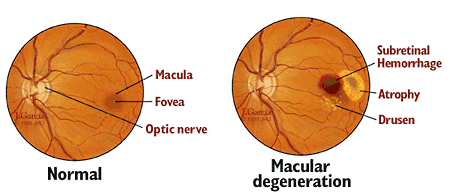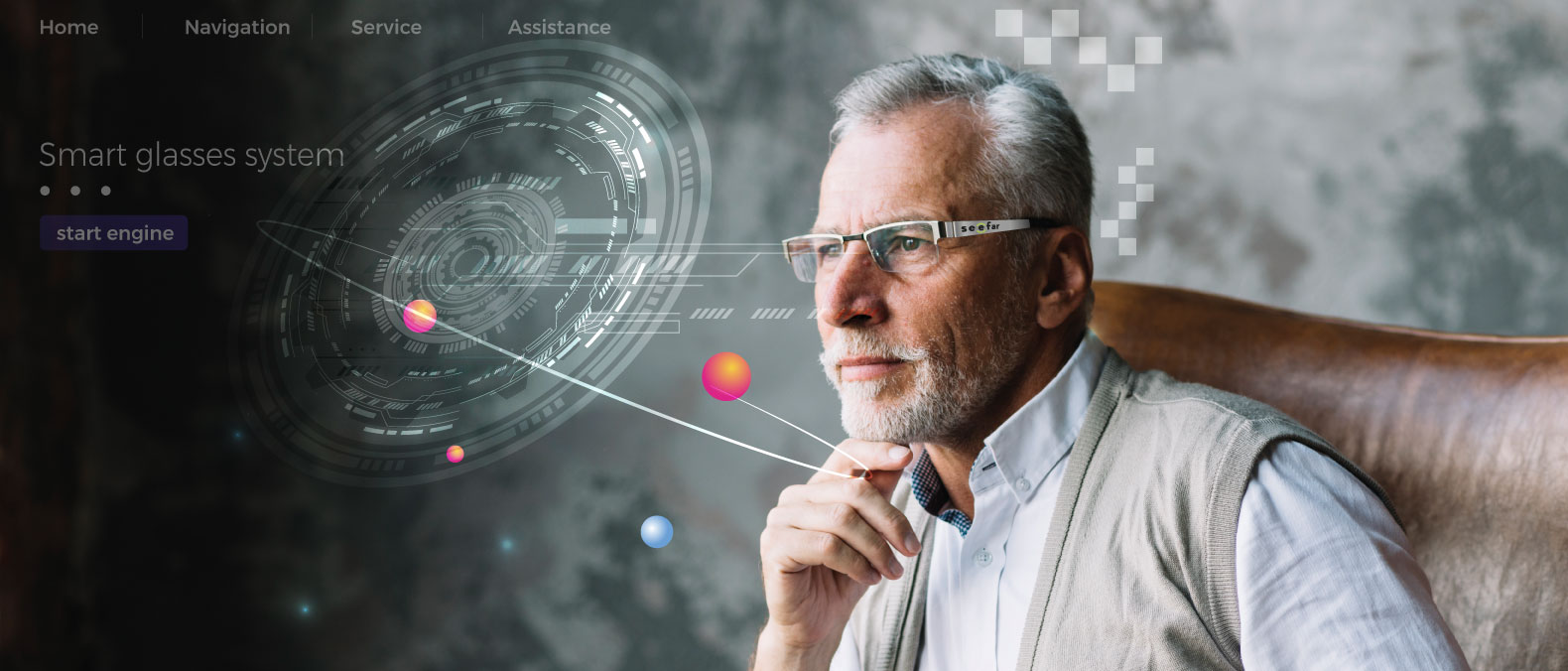
- What is AMD
Age-related macular degeneration (AMD) is a degenerative condition of the central retina (macula). In macular degeneration, very important light-sensitive photoreceptors and retina pigment epithelium begin to break down, causing gradual loss of the central vision. The condition may change to a more severe stage with severe vision loss and blindness1.
AMD is one of the leading causes of vision impairment globally and in 2020 the most common cause of blindness in developed countries. The number of people living with macular degeneration is expected to increase from 196 million worldwide in 2020 to 288 million by 2040 as a consequence of exponential population ageing2.
- Types of AMD, if there are any
The disease occurs in two forms, atrophic (“dry”) AMD and neovascular (“wet”) AMD. In atrophic AMD, cells in the macula in larger or smaller areas slowly lose the ability to convert light into electrical signals. This is because the waste substances from the metabolism in the retina accumulate in Bruch’s membrane causing yellowish deposits (drusen) and irregular distribution of pigment. The pathological changes in the Bruchs membrane can develop further and induce retinal pigmented epithelium and photoreceptors to decrease and slowly pass away. Over time, vision decreases. Atrophic AMD can progress over many years, with about 10-15% sudden transitioning to neovascular AMD. Neovascular AMD, happens due to the changes in Bruch’s membrane and the formation of new blood vessels under the macula. These newly formed blood vessels are, in contrast to the normal blood vessels thin-walled and leaky. As Bruch’s membrane is more porous, vessels will penetrate, and blood and fluid will leak into the retina distorting vision. This type of AMD is more serious than atrophic AMD and can result in severe vision loss. It can develop quickly and prompt treatment is needed when symptoms appear1.
- Symptoms of AMD
Age-related macular degeneration (AMD) affects a person’s central vision, which cannot be corrected with glasses. When reading or writing, gaps in the text and blurred areas may appear. Straight lines are perceived as curved or distorted (for example, the bars in the windows, the flagpole and the tiles in the bathroom), and colors seem darker or less vivid than they used to be. It becomes harder to recognize faces, drive a car and watch television although the visual impairment is most often experienced at a shorter distance and generally feels less bothersome when looking far away. In neovascular AMD, the vision changes appear suddenly and can lead to severe vision loss within a few weeks or months3.
- Cause of AMD
Age-related macular degeneration is caused by a complex interplay between the heritage and environment. The major risk factor for AMD is aging, genetic factors, and smoking. Research has focused on the role of diet, light exposure, and association with cardiovascular disease and its risk factors; however, the effects of these risk factors are less certain1.
- Traditional treatment
Neovascular AMD: Can be treated with injections of angiogenesis inhibitors (anti-VEGF) injections into the eye, in many cases every/every other month. The treatment will not cure neovascular AMD, but may slow the rate of vision decline or stop further vision loss. However, the disease and loss of vision may also progress despite treatment.
Previously different laser treatments (laser photocoagulation and PDT) where used more routinely, but with the introduction and advancement of anti-VEGF treatment, laser treatments are diminishing for the classes types of AMD, but are used in special cases or related conditions.10
Atrophic AMD: There is no treatment for atrophic AMD. It is estimated that approx. 5-10% of patients with atrophic AMD will develop the neovascular form over five years. A single larger prospective randomized study (AREDS) has shown a preventative effect of vitamin and mineral supplementation, as this could reduce the risk of certain forms of dry AMD developing further into wet AMD.4
- The person who has AMD can also be affected with other diseases that we are treating in the project, and if yes, which ones and why
Presbyopia: Almost everyone (with a natural lens) experiences some degree of presbyopia after the age of 40, as a natural part of aging. As a result, a person >40 years who has AMD is likely to also have some degree of presbyopia5, although presbyopia is not caused directly by AMD.
Cataract: Cataract is a part of the natural aging process and almost everyone (with a natural lens) will develop some number of cataracts during their lifetime. As a result, an elderly person who has AMD is likely to also have some degree of cataract6, although cataract is not caused directly by AMD.
- Is it caused by ageing
Yes, AMD is an age-related condition1.
- How does this disease influence our working life
Users with age-related macular degeneration have central blurred vision, metamorphopsia, and change in color perception, making it especially difficult for patients to read and recognize faces. When reading or working at a computer, gaps in the text/screen and blurred areas are seen. At a distance, AMD causes image loss and blurring of parts of the central field of view. It may be impossible to drive a car, bicycle or other moving vehicle3.
Vision impairment also increases the risk factors of social withdrawal and depression, absenteeism, early retirement and occupational injuries. It increases the risk of falls, and fear of falling can lead to general uncertainty, dependency, feeling unsafe, reduced social participation, and difficulties carrying out daily activities such as working life7.
- Can AMD be resolved with surgery
No, surgery will not resolve AMD. It has been proposed to use Implantable Miniature Telescope4 etc. to improve vision of patients with very poor vision due to end-stage AMD, but the treatment is only frequently used.
- The Covid 19 influenced treatments and scheduled appointments
COVID-19 has caused significant changes in ophthalmic practice. At the beginning of the pandemic, most ophthalmologists restricted their practice to visit only urgent cases. On March 11th 2020, American Academy of Ophthalmology (AAO) recommended ophthalmologists to stop all routine activities and restrict their treatment only to urgent and emergent cases8. Soon after there were concerns about providing proper care to e.g. AMD patients who needed long time follow-ups, multiple visits, and intravitreal injections. AAO then recommended that clinical activities could be performed with continued caution in compliance with local regulations. The known cases of COVID-19 should be quarantined at home and defer their ophthalmologic examination. In the case of urgent patients, strict precautions should be considered to take them directly to the examining room without any contact with others9.
- How important is the image analysis in this disease
Image analysis is very important for AMD diagnosis and follow-up. The See Far mobile application, which allows monitoring of the evolution of central vision, predicting the risk of disease presence, and estimating the type and stage of visual impairment is very important as the change and degeneration in the retina due to AMD can occur on the images.
- How the See Far glasses can help in prevention and monitoring the disease
The D-EYE camera can be used to monitor the retina over time. The patient with AMD will be able to monitor the progression of their eye disease by taking images of the retina with the D-EYE ophthalmic camera. These images will be analyzed by artificial intelligence and validated by the paired ophthalmologist.
- What are the benefits for the patient and why do we propose the See Far glasses to be used?
Patients with age-related macular degeneration have central blurred vision, metamorphopsia and change in color perception, making it especially difficult for patients to read and recognize faces. The See Far smart glasses, adapts to the needs of users and optimize their vision through the use of a personalized visual assistant that captures the condition of the eye, detect the problem, and provides the appropriate adjustment through the integration of reality technologies. By configuring the See Far smart glasses patients with AMD can magnify images and texts to reduce the perceived central scotoma, better illuminate specific areas. Augmented reality technology can also be used for recognition of warning of obstacles or dangers during walking around.
Through the notifications offered by the See Far mobile application, the user will receive specific reminders about the most appropriate diet for the specific pathology, as well as recommendations for healthy living. The See Far smart glasses are aimed at workers with visual impairments due to age-related macular degeneration. It will allow the user to remain active in their professional and personal life, to remain independent, active, and healthy.
Sources
1: The International Agency for the Prevention of Blindness, Age-related macular degeneration, https://www.iapb.org/learn/knowledge-hub/eye-conditions/age-related-macular-degeneration/
2: The Lancet Global Health, Volume 2 Issue 2, https://www.sciencedirect.com/science/article/pii/S2214109X13701451#bib4
3: National Eye Institut, https://www.nei.nih.gov/learn-about-eye-health/eye-conditions-and-diseases/age-related-macular-degeneration
4: Bright Focus Foundation, https://www.brightfocus.org/macular/treatments
5: The International Agency for the Prevention of Blindness, “Position Paper on Presbyopia”, https://www.iapb.org/learn/resources/position-paper-on-presbyopia/
6: The International Agency for the Prevention of Blindness, “Cataract”, https://www.iapb.org/learn/knowledge-hub/eye-conditions/cataract/
7: NCBI, “Sensory impairments in community health care: a descriptive study of hearing and vision among ederly Norwegians living at home” https://www.ncbi.nlm.nih.gov/pmc/articles/PMC4045259/
8: American Academy of Ophthalmology, “Recommendations for urgent and nonurgent patient care”, https://www.aao.org/headline/new-recommendations-urgent-nonurgent-patient-care
9: IJO, “Ophthalmic practice during COVID-19 pandemic”, http://ies.ijo.cn/gjyken/ch/reader/view_abstract.aspx?file_no=20210501&flag=1
10: Eyewiki: Age-Related Macular Degeneration: https://eyewiki.aao.org/Age-Related_Macular_Degeneration

